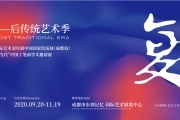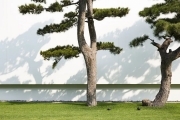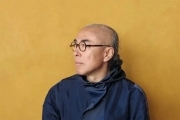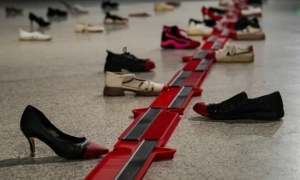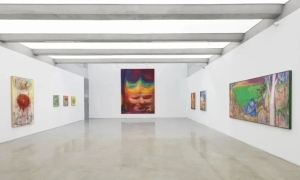伴随着中国的崛起,现代性问题早已成为中国社会所面对的首要问题之一,恐怕这也是中国当代艺术所面对的首要问题之一。但是,打中国牌的大有人在,而正面应对中国这种特殊的现代性问题的艺术家却为数不多。从翁奋2001年的《骑墙》、2002年的《鸟瞰》、2003年《观景台》装置系列和《看海》来看,他却恰恰是这为数不多者中的一个。在这些作品中,他一直把目光锁定在城市人的心理现实之上,用心把握全球化背景下中国经济快速增长所带来的种种社会心理的变化和落差。翁奋的摄影总让人有一种挥之不去的内心感慨,这种感慨复杂莫名。因为他的作品总是把现代性背景下许多原本相对孤立的传统与现代、经济全球化与中国方式、都市消费社会与发展失衡等话题密集地纠缠、交织在一起,全方位地牵制、唤醒我们意识深处与之密切相关的一根根细微的感受神经,从而引发我们强烈的内心挣扎和情绪激荡,难以自已。翁奋的作品总让我们有一种进入角色而无法置身度外的心理投射体验。站在翁奋的“骑墙”少女、“鸟瞰”少女的身后,沿着她们的视线一同去看那些巨无霸式的现代城市。我们内心不再有狂喜,领略到的是一种亘古的孤独和沉重的心理负担。面对现代性问题,身在其中的我们的确已无法回避。但,相比那些身影单薄的少女,我们是否会显得更加茫然、更加无能为力?
翁奋显然没有去坐看云起,而是不断推出新作,以作品不断地提出问题,不断追究解决方案。2005年的新作《累卵计划》无疑是他追究内心问题的新的物化形式。其实,翁奋《累卵计划》方案早在2004年底就已确立,并为艺术圈内人士熟知。但由于工程浩大,作品直至2005年8月才告完成。翁奋动用上万颗鸡蛋和数量稍逊的鸭蛋、鹌鹑蛋的去液整蛋蛋壳,构成了一个长8米、宽4米、高1米的城市建筑的缩微沙盘。如果临高俯视,可以辨认出所有的建筑造型都脱胎自一幅完整的50元人民币纸币的图案。这张人民币纸币呈青绿色,图案居中是代表工人、农民、知识分子的三个巨大的侧面头像。该纸币当下仍在社会流通。在人民币平面图案上累积起来的蛋卵造型,恍如从人民币中生长起来的建筑森林,形象地组成了全球化条件下的一个中国式城市的模型。翁奋在累卵过程中也是险象环生,作品有几次差一点告败。这样的经历,似乎以感应的方式表现了他对国家政治经济生态的一种深切关怀。整个创作期间,他先是经历了欧美针对人民币升值的全球施压和论争。直至到了2005年7月21日,中国政府打破汇率坚冰,放弃长期以来人民币紧盯美元的固定汇率制,使人民币兑美元升值大约两个百分点,引起举世轰动。翁奋的艺术计划似乎构成了一则有关国际政治经济风云突变的神秘预言。那些不断累加起来的蛋,好像预先演示了人民币的升值事实以及继续升值的可能性。翁奋将都市化的表象置于人民币图案所象征的经济基础之上,强调的无疑是现代性在中国的崛起与国际、国内的政治经济生态的本质关联,并未刻意渲染对人民币升值的预期。然而,政治经济现实的变化无常却为艺术家提出问题、讨论问题提供了绝佳的语境。众所周知,“累卵”的含义出自中国春秋时期一个古老成语“危如累卵”,该词常用来形容非常危险的境地。在此,翁奋忧虑表达的现实针对性是不言而喻的。艺术家究竟是否以自己塑造作品的成功几率和心理防线来试探人民币升值的潜在危机?这一点无法求证。但是,更富弹性的汇率机制的出现,说明艺术与政治经济现实之间的互动不仅可能,而且十分实际,并往往带有异常的感性因素。
撇开与现实的巧合,《累卵计划》首先关注的仍然是凌驾于人民币图案之上那个高速发展的城市。毕竟,翁奋在作品中针对城市发展所突现出的现代性问题,展示了他一以贯之的文化洞察力。1990年代以来,建设进行时已经成为中国各城市的常态。红尘万丈、轰轰烈烈的城市再造运动成了中国式现代性最重要的表征之一。空前规模的拆迁和发展,彻底抹去许多城市特殊的历史记忆和人文风貌,并塑造出许多建筑风格整体雷同、无个性的大城市。现代化进程已然深入到中国城市社会的每一个角落、城市生活的每一个细节、城市文化风貌的每一寸骨髓。城市的急剧都市化,让一切突变都在人们日常的、熟视无睹的现实守望中悄然实现。许多微妙而细小的变化迅疾地累积起来,并迅疾地改变了中国社会原有的相对稳定的内在结构,发展不均、贫富差距、社会鸿沟等问题纷纷浮出水面。对于安于现状、惯看电视中表面繁荣和歌舞升平的普通人来说,只有事到临头,他才会相信自己已然身处的社会转型期的风口浪尖,相信许许多多事端并不是一夜之间跑出来的。事实上,长期以来经济增长的高歌猛进覆盖、屏蔽了的太多的问题。由于多年来物价相对稳定,拆迁成为触及许许多多普通人利益、真正打破他的生活常态的一大突发事端。城市再造运动造成的种种问题,让人顿悟到社会变革的无可回避,同时也意识到发展与风险共存的客观事实。然而,艺术家却始终是敏感的,能够发微见著地把握问题的关键,而且往往有超常的前瞻性。翁奋通过《累卵计划》精心构筑一种不祥预感,来表达他对现代性的忧思。他在每个椭圆形的蛋壳上喷上防腐用的高光亮胶,再用亮胶将蛋壳整齐地一个码一个、一个摞一个地粘连起来,树立在作品底座上,形成各种城市建筑的缩微造型。灯光下,蛋壳个个珠圆玉润,折射着光晕。各种蛋壳组合的建筑造型也都玲珑剔透,既酷又亮丽。所有的蛋壳“建筑”以极具装饰性的方式指向未来的城市模式。无疑,光鲜的未来和神圣光环中的精神家园才是《累卵计划》真正关注的议题。让人饶有兴味的是,这件气势恢宏的装置作品几乎可以看作为奥尔德斯•赫胥黎《美丽新世界》的某种视觉艺术呈现样本。赫胥黎写于1932年的小说《美丽新世界》从对现代化的担忧出发营造了的一个“反乌托邦”。 在这个已经完成了全球化的新世界中,人类可以被批量克隆生产,生产时他们就被分成等级。每一个人都从小就被灌输“如今人人都快乐”、“进步就是美好”的必要教条。在这个“共有、划一、安定”的新世界里,即使是低等级的人,也是快乐的。他们经过七个半小时和缓又不累人的劳动之后,就有迷幻药口粮、游戏、无限制性交和刺激感官的电影可供娱乐。因此他们对自身的处境毫无怨恨,相反还相当满足。这就是小说一再强调的“如今人人都快乐”的境界。当今,仍有许多欧美知识分子认为,赫胥黎的预言现正在实现,经济全球化的噩梦创造出了许多几乎一模一样的城市、几乎一模一样的城市生活方式。这种克隆式的创造正在让人类丰富无比的文化精神走向枯萎。翁奋的《累卵计划》是一个从中国经济语境出发树立的具有全球化、现代性的城市标本,其中所提炼出的抽象本质,无疑是一种对发展中国家的城市发展划一化的绝佳讽喻。《累卵计划》只是城市无限膨胀的一种象征。它对我们现有的盲目乐观主义发展观构成一个警示。如果我们仍在片面地、毫无节制地追求的城市扩张和发展,而忘记对有形和无形的既有文化财富的保护,忘记资源与环境发展的平衡性,仅仅陶醉于这种扩张和发展所带来的所谓“国际化大都市”的虚假繁荣,我们的城市也许就会成为空心的、缺乏文化和精神实质的蛋壳城市。而我们心往神驰的现代化,也会变成一个《美丽新世界》那样的“反乌托邦”。
《累卵计划》像一个使用了特殊材质的超大型的建筑沙盘,激活的是观者超凡的想象力和物质审美主义热情。众所周知,看楼是中国所有高速发展的大城市的一大社会热点。随着房地产的不断升温,大量购房者、炒楼者和更大量的有购房动机者纷纷穿梭于各种新楼盘之间,面对一一个造型各异、但一律制作精美的缩微建筑沙盘,或进入精心装修的样板间。他们的触景生情和完美想象,无不基于对将来生活空间和生活方式的一种憧憬。同样的经验也产生在房展会上,观看者从一个沙盘簇拥到另一个沙盘,寻找着填充自己理想和未来那一个个具体的空间。翁奋深深了解发生在城市膨胀过程中这种视觉经验的现实,在日常生活中,看楼已成为人们追求更大、更长久的利益和幸福感的社会行为。他仿照建筑沙盘的样式塑造《累卵计划》,有心让观者备感亲切,激发出审美惯性所驱驰的想象力及其误读的可能性。翁奋的《累卵计划》其实是一个没有具体指代对象的建筑沙盘,具有乌托邦色彩,与那些售楼处沙盘,甚至与那些城市规划馆的新城区展示沙盘都有本质的不同。那些看楼者司空见惯的沙盘,往往精致得像工艺品一样,虽然都有专门的现实指代对象,但却一个个出落得超凡脱俗,具有不同程度的超日常特征。那些沙盘凝聚并突出了那些将要成为现实的楼盘、城区的一切优点,同时省略了几许缺陷和问题。一句话,极具卖相,符合消费社会大趋势。于是,观看者视觉愉悦的即时经验也往往传导了一种想象的快感,而集体性的想象又提升了他们对更高生活品质的追求,鼓舞了他们越来越超前的消费热情。翁奋的《累卵计划》的超日常特征更为显著,已有超现实之感。面对这个超大沙盘,经验丰富的观者依然能辨认出住宅楼、写字楼、会所、商业区,乃至电视塔、CBD、体育馆、绿化带、人工湖、游乐园、高架桥等等。然而,这个蛋壳塑造的城市让人既熟悉又陌生。它既神似我们在经济高速增长期游历过的任何一个中国城市,但又都不像。所有建筑道具的造型都来自翁奋对不同城市记忆的分别抽样和重塑。看惯沙盘的观者在经验被唤醒的同时,也许内心会有一种怅然若失之感。他们无限膨胀的消费欲望在这个大沙盘上竟无所寄托。毕竟,这个沙盘以抽离现实性的方式超越了人们的日常经验。然而,当观者深入观看作品时,一种隐忧又悄然出现,人们在社会转型期所追求的安全感,在这里竟无处安顿。人们孜孜以求城市生活和更好的居所,原本是为了获得一种社会地位、经济条件和生活质量的最有效保障。然而,《累卵计划》所象征的这样一个城市让人根本无法张扬自己的想象力,因为任何的心理投射都落不到实处。蛋壳的脆弱易碎的特性具有某种关于经济泡沫的寓言特征,这对普遍追求利好的一厢情愿者具有强烈的精神暗示。我们所在高楼大厦、城市是否坚实?或者说,我们的幸福所在是否有一个坚实的经济基础?这是每个面对《累卵计划》的观者都会产生的联想。翁奋的《累卵计划》是一件吸引人不断去重新观看的作品。就在观者的不断观看中,这件作品通过对人们内心的盲目自信和安全感悄悄剥夺,引发一种深度的针对人性的心灵震撼。既然趋利避害是人之天性,那么,我们能否真正懂得尊重自然和环境,遵循平衡发展、可持续发展乃至长远发展的规则?《累卵计划》作为一个反面乌托邦所呈现的人工光芒,无疑警示着沉浸在快乐原则和欲望游戏中的人们。翁奋利用蛋壳苦心孤诣营造的这个危机四伏的“美丽新世界”,显然已不再是我们憧憬已久的精神家园。可想而知,如果我们在城市规划发展中不及早作出紧急调整,改变现状,准备预案,崩盘的一天也许真的会到来。《累卵计划》的沙盘样式,让翁奋近距离地披露城市发展的矛盾,再一次地走进城市人的内心冲突,提示出现代性的危机下某种集体无意识的脆弱和虚妄。
当代艺术的生命力在于实验。《累卵计划》是翁奋现代性实验室又一出品。这件貌似儿时积木游戏的作品,却言简意赅,显示了艺术家独到的视角和沉静的文化反省的态度。既然现代性问题在某种意义上是中国许多经济、社会、文化问题的源头,那么,翁奋直面中国现代性问题的勇气,正代表了一种知识分子积极入世、及时进行社会批评的现实立场。这种立场在如今的艺术圈内,其实已不多见了。
Weng Fen's Beautiful New World
By Gu Zhengqing, curator
With the rising of China, the issue of modernity has become the top priority across the country. It is, I believe, also one of the key issues the Chinese contemporary art community has to address. Nevertheless, despite a huge number of artists who like to advocate their Chinese identity, few have made any attempt to express their thoughts on this special phenomenon. Weng Fen is one of the few artists who have created many series of work to depict the changes of urban residents’ mentality as well as the discrepancy between their expectation and the reality of the society, both caused by the nation’s rapid economic development in a global setting. His works include “On the Wall” photo series (2001), “Bird's Eye” photo series (2002), installation “Viewing Stand” (2003) and “Staring at the Sea” photo series. The photos taken by Weng Fen always leave the viewers with a complicated sensation that recedes slowly. In his works, issues of traditional and modern life, economic globalization and China’s own path, as well as the unbalanced development in the urban consumer society are intertwined in the common background of modernity. Therefore, his work brings out subtle emotions that used to hide deep in our minds, leading to strong and irresistible emotional fluctuations. We also get the feeling of becoming an integral part of the pictures: standing right behind the girls in his “On The Wall” and “Bird's Eye” series, we are looking in the same direction at the gigantic modern cities. Instead of being in an ecstasy of delight, we, as a part of the development process toward modernization, inevitably experience a timeless solitude and great mental burden. Compared with the thin girls in the pictures, it is us that appear to be lost more deeply in a state of helplessness.
Weng Fen continues his exploration of the modernity issue by turning out new pieces of work, hoping to find a solution. His work in 2005, “Building with Eggs”, is one such attempt. This project was started at the end of 2004 and has been widely known to the Chinese art community since then. Due to the huge amount of work it requires, it was finished only recently in August, 2005. Around ten thousand chicken eggs and slightly fewer duck and quail eggs with their contents removed were used in the project to constitute an 8×4×1m miniature model city. Viewing from above, people see a complete picture taken from the image on a 50-yuan banknote. The green banknote, still in circulation now in China, shows the profiles of a worker, a peasant and an intellect in the middle of it. Like a concrete forest growing out of the banknote, the model vividly represents a typical Chinese city developing in a competitive international environment. Problems occurred frequently during the process of creation, which almost led to a complete failure several times. I believe this experience reflects the similarly unstable state of the nation's economic and political environment. Shortly after the project started, the Chinese government was urged by the US and Europe to revaluate its RMB, triggering heated debates around the globe. In July 21, 2005, after months of pressure from the US and Europe, China scrapped the Yuan's peg to the US dollar and raised its exchange rate with the US dollar by two percent, which attracted the attention of the entire world. The project of Weng Fen, therefore, seems to be a mystical prophesy on this event in the ever-changing world. The eggs building high on top of each other are a sign of the present appreciation of RMB and the potential of further appreciation. The whole modern city in Weng's installation finds its foundation in a banknote that symbolizes the economic basis for development. Of course, the artist did not create the project to show his anticipation of the appreciation of the currency. It is the essential relationship between the country’s rapid shift to modernization and the political and economic situation home and abroad that he is emphasizing on. The current environment is obviously the best for artists to express their ideas about the issues they are concerned with through their work. The title of the project, “Building with eggs”, has its origin from an ancient Chinese idiom that date back to the Chunqiu Period (770-476 BC), “as precarious as a pile of eggs”, meaning “in an extremely dangerous situation.” It clearly indicates the artist’s concern over the reality. Maybe he intends to imply the possible crisis caused by the appreciation of the currency in his work, as uncertainty remains throughout the whole process of creation, but we don’t know the exact answer. China’s adoption of a more flexible exchange rate regime is a proof that the interaction between art and reality, both political and economical, is not only possible, but also practical, though the artists’ understanding of the reality usually tend to be perceptual.
In spite of the coincidence with the reality, “Building with Eggs” focuses on the fast-developing city model which features the picture on a 50-yuan note. This installation, together with his other works, demonstrates his keen insight into the problems arising from China's modernization process. Ever since the 1990s, cities across the nation have been going through large-scale construction work in order to realize modernization. City reconstruction movement has become one of the most distinctive features of the country. As large parts of old cities are being torn down, the government has to relocate a large number of city dwellers. Unfortunately, many sites of historical and cultural importance have been wiped out while people are trying to build their cities into metropolitans. After excessive reconstruction, cities lose their own features and start to look the same. Up until now, the modernization process has influenced practically every city around the country and become a part of urban life and culture. All the changes are integrated into people's daily life and they damage the once stable social structure, leading to problems such as the widening gap between the rich and the poor as well as between the western and eastern regions. Common people, who are content with the status quo, tend to believe what the propaganda system wants them to: that they are enjoying carefree prosperity. Only when their interests are affected by city reconstruction can they realize that problems are deep-rooted in this transforming society. In fact, many problems are overshadowed by China's long-lasting economic growth. As the price level remains stable for years, relocation has become the key issue that disturbs people’s normal life, which makes them realize all of a sudden that social changes can not be avoided, nor neglected. On the other hand, artists are sensitive enough to grasp the core of these problems and are able to stay ahead of time. Weng Fen expresses his anticipation of possible problems and his worries about modernization in his “Building with Eggs”. Every egg was first sprayed with shiny, high-luster gum to keep them from deterioration. Then they were glued on a piece of board by the gum to form models of city architecture with different shapes. The city model looks as cool and glistening as the eggs themselves under the spotlight. All the decorative eggshell “buildings” have the style of a future city conceived by the artist. It is obvious that a sacred spiritual home in a bright future is what “Building with Eggs” is trying to display. Interesting enough, this magnificent installation can be seen as a visual demonstration of the world created in “Brave New World” by Aldous Huxley. Written in 1932, the novel depicted an anti-utopian World State in which residents suffered greatly. In that globalized world, babies were produced by the cloning technology and segregated into various castes once they were born. Through the use of science, babies were also conditioned to guarantee they would be happy members of the advanced society, the motto of which was “Community, Identity, Stability.” Even people of lower castes were trained to be content with their lives. After seven hours of light work, they could take drugs, indulge themselves in promiscuity and enjoy "Feelie," a movie that stimulates the senses of sight, hearing, and touch. Each person's “happiness” was maximized as a result of their social conditioning and stunted development. Now many European scholars still believe that the prognostication made by Huxley is coming true as we can recognize so many contemporary parallels there are to the World State. Economic globalization has brought about a large number of identical modern cities where people have the same life style. Diversified and rich human culture has been seriously damaged in the “cloning” of metropolitan cities. Weng Fen's “Building with Eggs” is the representation of a modern and globalized Chinese city desperate for economic growth and is an excellent satire of the identical urban planning of cities in China and other developing countries. As a symbol of the ever- expanding cities, the installation warns people to stay clear of blind optimism. If we don't refrain from excessive urban construction and expansion and stop being indulged in the superficial prosperity of the “metropolises”, cities will be deprived of their culture and spirit and become as hollow as eggshells. We have to protect the tangible and intangible cultural heritage and maintain a balance between the consumption of resources and the protection of environment. Otherwise, the modernized cities we crave for will turn out to be another “Brave New World”.
The installation “Building with Eggs” looks like a huge sand table model made from special materials, which stimulates viewers' imagination and their passion for consumerism. As the real estate market has heated up dramatically in recent years, building inspection is popular among residents in the growing cities in China and a huge number of people who intend to invest in the market are busy visiting different new buildings under construction. When they are looking closely at various delicate sand table models and sample rooms decorated extravagantly, they like to dream of their perfect future lives in these buildings. They are also frequent visitors of real estate exhibitions, moving from one model to another, looking for their idealistic future apartments. Weng Fen has a profound understanding of the fact that in expanding Chinese cities, people are looking for greater benefits and an enduring sense of happiness by investing in the real estate market. “Building With Eggs” follows the format of a sand table model, thus making viewers feel familiar and stimulating their imagination. But it should not be considered the same as a common model in a building's sales office or a city’s urban-planning exhibition hall, because they are different in essence --- the installation does not have a specific area to be modeled after. Instead, it displays a Utopia. Misconceptions may occur if people fail to realize the disparity. Sand tale models are usually built exquisitely as if they were pieces of craftwork. By highlighting the good features and eliminating some shortcomings of the actual place, they all appear to be unrealistically magnificent and attractive to consumers. Inspired by the outlook of a wonderful life in a new apartment exhibited in the models, the viewers are enthusiastic to buy a condominium, even if they have to apply for a mortgage, as they desire to improve their living standards in this way. Experienced viewers can recognize in the model city of “Building With Eggs” many familiar things, including apartment buildings, business centers, clubs and CBD. They can even find a television tower, a stadium, grass lands, artificial lakes, theme parks and viaducts. However, even though its appearance can be linked to any Chinese city in the current economic boom, the super-realistic eggshell city refers to none of them. The design of the city originates from Weng Fen’s memory of different cities. The viewers who are used to common models may feel at a loss when they are looking at the model city, because they can’t buy anything on display. Most city residents have been devoting themselves to getting better apartments with the intention to raise their social status and ensure the quality of their lives in this transforming society. But they can’t realize their dreams of securing a happy life in a city that only exists in the form of an eggshell model. The fragileness of eggshells represents the unstable state of the economy frequently troubled by “bubbles”, which is usually ignored by the over-optimistic. The eggshell installation encourages viewers to think about many questions: Are the buildings in our cities reliable? Do our happy lives have a solid foundation? The installation also attracts viewers to inspect it further and leads them to face the shocking reality. As it is human nature to seek benefits and avoid harm, we should respect nature and pursue balanced and sustainable development. As a matter of fact, the “Beautiful New World” built through Weng Fen's great efforts does not qualify for a perfect spiritual home for us human being as it carries the risk of collapsing at any moment. As an anti-utopia, the eggshell city warns the people who only care about satisfying their own desire and seeking their own “happiness” that if we don't improve our urban planning and construction immediately, the day of collapse will not be very far ahead. As an artist who understands the minds of city dwellers, Weng Fen exposes the problems in urban development through a sand table model and reveals the fragileness and falseness of ignorant people trapped in this modern development crisis.
The life of contemporary art lies in experimenting. “Building with Eggs” is the latest “experiment” carried out by Weng Fen's “modern art lab”. Like a model built with toy bricks by a child, the simple yet meaningful installation reflects the unique viewpoint of the artist and his insight into social and cultural issues. As modernization is, to some extent, the origin of many economic, social and cultural problems in China. The courage Weng Fen shows when he addresses these problems through his works is an example of the artist’s rational criticism of the society and his active participation into the current social life, which is quite rare in China’s art scene now. (Translated by Steven Huang)
【编辑:张瑜】



